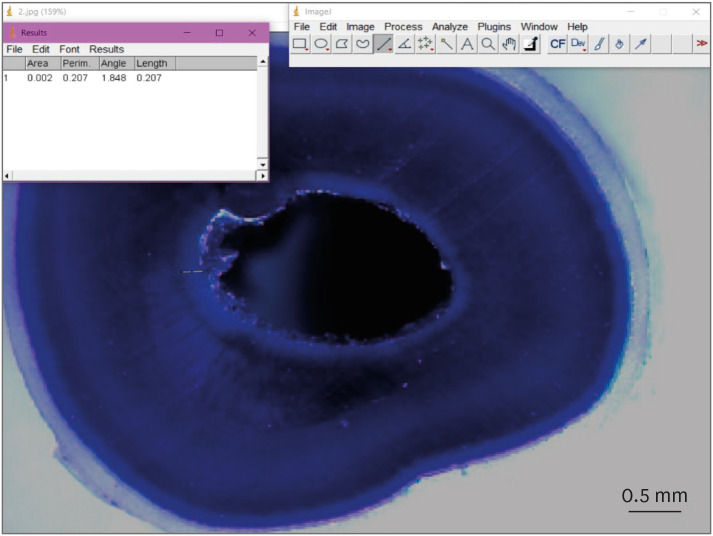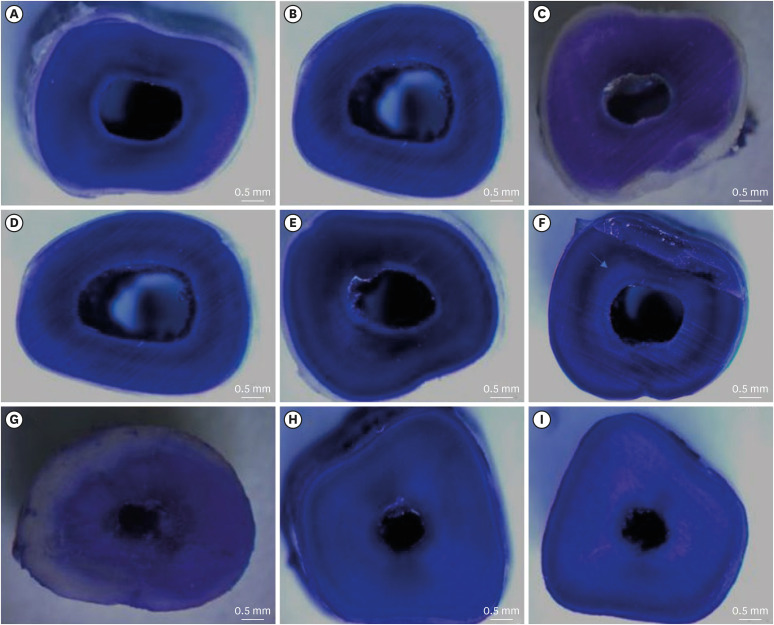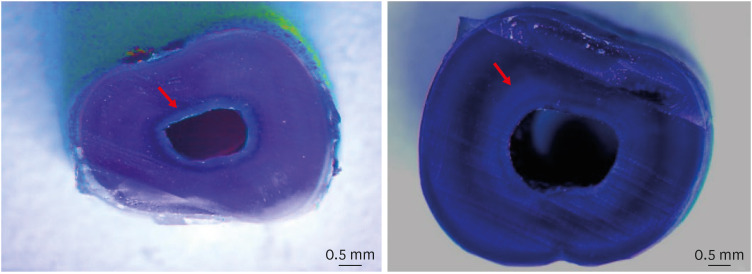Restor Dent Endod.
2023 Feb;48(1):e1. 10.5395/rde.2023.48.e1.
Dentinal tubule penetration of sodium hypochlorite in root canals with and without mechanical preparation and different irrigant activation methods
- Affiliations
-
- 1Department of Conservative Dentistry, School of Dentistry, Federal University of Rio Grande do Sul (UFRGS), Porto Alegre, RS, Brazil
- 2Department of Endodontics, School of Dentistry, University of Passo Fundo (UPF), Passo Fundo, RS, Brazil
- 3Department of Endodontics, School of Dentistry, State University of Western Paraná (UNIOESTE), Cascavel, PR, Brazil
- KMID: 2548169
- DOI: http://doi.org/10.5395/rde.2023.48.e1
Abstract
Objectives
This study evaluated the dentinal penetration depth of 2.5% sodium hypochlorite (NaOCl) in root canals with and without preparation and different irrigant activation protocols.
Materials and Methods
Sixty-three bovine mandibular incisors were randomly allocated to 6 groups (n = 10): G1, preparation + conventional needle irrigation (CNI); G2, preparation + passive ultrasonic irrigation (PUI); G3, preparation + Odous Clean (OC); G4, no preparation + CNI; G5, no preparation + PUI; G6, no preparation + OC; and CG (negative control; n = 3). Samples were filled with crystal violet for 72 hours. Irrigant activation was performed. Samples were sectioned perpendicularly along the long axis, 3 mm and 7 mm from the apex. Images of the root thirds of each block were captured with a stereomicroscope and analyzed with an image analysis software. One-way analysis of variance, followed by the Tukey post hoc test, and the Student’s t-test were used for data analysis, with a significance level of 5%.
Results
The NaOCl penetration depth was similar when preparation was performed, regardless of the method of irrigation activation (p > 0.05). In the groups without preparation, G6 showed greater NaOCl penetration depth (p < 0.05). The groups without preparation had a greater NaOCl penetration depth than those with preparation (p = 0.0019).
Conclusions
The NaOCl penetration depth was similar in groups with root canal preparation. Without root canal preparation, OC allowed deeper NaOCl penetration. The groups without preparation had greater NaOCl penetration than those undergoing root canal preparation.
Figure
Reference
-
1. Murray PE, Garcia-Godoy F, Hargreaves KM. Regenerative endodontics: a review of current status and a call for action. J Endod. 2007; 33:377–390. PMID: 17368324.
Article2. Banchs F, Trope M. Revascularization of immature permanent teeth with apical periodontitis: new treatment protocol? J Endod. 2004; 30:196–200. PMID: 15085044.
Article3. Kim SG, Malek M, Sigurdsson A, Lin LM, Kahler B. Regenerative endodontics: a comprehensive review. Int Endod J. 2018; 51:1367–1388. PMID: 29777616.
Article4. Iwaya SI, Ikawa M, Kubota M. Revascularization of an immature permanent tooth with apical periodontitis and sinus tract. Dent Traumatol. 2001; 17:185–187. PMID: 11585146.
Article5. Jeeruphan T, Jantarat J, Yanpiset K, Suwannapan L, Khewsawai P, Hargreaves KM. Mahidol study 1: comparison of radiographic and survival outcomes of immature teeth treated with either regenerative endodontic or apexification methods: a retrospective study. J Endod. 2012; 38:1330–1336. PMID: 22980172.
Article6. American Association of Endodontists (AAE): AAE clinical considerations for a regenerative procedure. Revised 6-8-16. updated 2016. cited January 14, 2022. https://www.aae.org/uploadedfiles/publications_and_research/research/currentregenerativeendodonticconsiderations.pdf .7. Galler KM, Krastl G, Simon S, Van Gorp G, Meschi N, Vahedi B, Lambrechts P. European Society of Endodontology position statement: revitalization procedures. Int Endod J. 2016; 49:717–723. PMID: 26990236.
Article8. Verma P, Nosrat A, Kim JR, Price JB, Wang P, Bair E, Xu HH, Fouad AF. Effect of residual bacteria on the outcome of pulp regeneration in vivo . J Dent Res. 2017; 96:100–106. PMID: 27694153.
Article9. Vishwanat L, Duong R, Takimoto K, Phillips L, Espitia CO, Diogenes A, Ruparel SB, Kolodrubetz D, Ruparel NB. Effect of bacterial biofilm on the osteogenic differentiation of stem cells of apical papilla. J Endod. 2017; 43:916–922. PMID: 28416302.
Article10. Lee C, Song M. Failure of regenerative endodontic procedures: case analysis and subsequent treatment options. J Endod. 2022; 48:1137–1145. PMID: 35714726.
Article11. Martin DE, De Almeida JF, Henry MA, Khaing ZZ, Schmidt CE, Teixeira FB, Diogenes A. Concentration-dependent effect of sodium hypochlorite on stem cells of apical papilla survival and differentiation. J Endod. 2014; 40:51–55. PMID: 24331991.
Article12. Elnaggar SE, El Backly RM, Zaazou AM, Morsy Elshabrawy S, Abdallah AA. Effect of different irrigation protocols for applications in regenerative endodontics on mechanical properties of root dentin. Aust Endod J. 2021; 47:228–235. PMID: 33314440.
Article13. Zeng Q, Nguyen S, Zhang H, Chebrolu HP, Alzebdeh D, Badi MA, Kim JR, Ling J, Yang M. Release of growth factors into root canal by irrigations in regenerative endodontics. J Endod. 2016; 42:1760–1766. PMID: 27871480.
Article14. Galler KM, Grubmüller V, Schlichting R, Widbiller M, Eidt A, Schuller C, Wölflick M, Hiller KA, Buchalla W. Penetration depth of irrigants into root dentine after sonic, ultrasonic and photoacoustic activation. Int Endod J. 2019; 52:1210–1217. PMID: 30828819.
Article15. Virdee SS, Farnell DJ, Silva MA, Camilleri J, Cooper PR, Tomson PL. The influence of irrigant activation, concentration and contact time on sodium hypochlorite penetration into root dentine: an ex vivo experiment. Int Endod J. 2020; 53:986–997. PMID: 32163598.
Article16. Tungsawat P, Arunrukthavorn P, Phuntusuntorn P, Opatragoon S, Sirirangsee P, Inklub S. Comparison of the effect of three irrigation techniques and root canal preparation size on sodium hypochlorite penetration into root canal dentinal tubules. Int J Dent. 2021; 2021:6612588. PMID: 33859692.
Article17. Sasanakul P, Ampornaramveth RS, Chivatxaranukul P. Influence of adjuncts to irrigation in the disinfection of large root canals. J Endod. 2019; 45:332–337. PMID: 30803542.
Article18. Dos Reis S, Cruz VM, Hungaro Duarte MA, da Silveira Bueno CE, Vivan RR, Pelegrine RA, Bruno KF, Kato AS. Volumetric analysis of irrigant extrusion in immature teeth after different final agitation techniques. J Endod. 2020; 46:682–687. PMID: 32139265.
Article19. Faria G, Viola KS, Coaguila-Llerena H, Oliveira LR, Leonardo RT, Aranda-García AJ, Guerreiro-Tanomaru JM. Penetration of sodium hypochlorite into root canal dentine: effect of surfactants, gel form and passive ultrasonic irrigation. Int Endod J. 2019; 52:385–392. PMID: 30220093.
Article20. van der Sluis LW, Vogels MP, Verhaagen B, Macedo R, Wesselink PR. Study on the influence of refreshment/activation cycles and irrigants on mechanical cleaning efficiency during ultrasonic activation of the irrigant. J Endod. 2010; 36:737–740. PMID: 20307755.
Article21. Haapasalo M, Ørstavik D. In vitro infection and disinfection of dentinal tubules. J Dent Res. 1987; 66:1375–1379. PMID: 3114347.22. Brittan JL, Sprague SV, Macdonald EL, Love RM, Jenkinson HF, West NX. In vivo model for microbial invasion of tooth root dentinal tubules. J Appl Oral Sci. 2016; 24:126–135. PMID: 27119760.23. Kakoli P, Nandakumar R, Romberg E, Arola D, Fouad AF. The effect of age on bacterial penetration of radicular dentin. J Endod. 2009; 35:78–81. PMID: 19084130.
Article24. Kontakiotis EG, Tsatsoulis IN, Filippatos CG, Agrafioti A. A quantitative and diametral analysis of human dentinal tubules at pulp chamber ceiling and floor under scanning electron microscopy. Aust Endod J. 2015; 41:29–34. PMID: 24931599.
Article25. Gründling GL, Zechin JG, Jardim WM, de Oliveira SD, de Figueiredo JA. Effect of ultrasonics on Enterococcus faecalis biofilm in a bovine tooth model. J Endod. 2011; 37:1128–1133. PMID: 21763907.
Article26. Schilke R, Lisson JA, Bauss O, Geurtsen W. Comparison of the number and diameter of dentinal tubules in human and bovine dentine by scanning electron microscopic investigation. Arch Oral Biol. 2000; 45:355–361. PMID: 10739856.
Article27. Camargo CH, Siviero M, Camargo SE, de Oliveira SH, Carvalho CA, Valera MC. Topographical, diametral, and quantitative analysis of dentin tubules in the root canals of human and bovine teeth. J Endod. 2007; 33:422–426. PMID: 17368331.
Article28. Schmalz G, Hiller KA, Nunez LJ, Stoll J, Weis K. Permeability characteristics of bovine and human dentin under different pretreatment conditions. J Endod. 2001; 27:23–30. PMID: 11487159.
Article29. Gu Y, Perinpanayagam H, Kum DJ, Yoo YJ, Jeong JS, Lim SM, Chang SW, Baek SH, Zhu Q, Kum KY. Effect of different agitation techniques on the penetration of irrigant and sealer into dentinal tubules. Photomed Laser Surg. 2017; 35:71–77. PMID: 27929924.
Article30. Vadhana S, Latha J, Velmurugan N. Evaluation of penetration depth of 2% chlorhexidine digluconate into root dentinal tubules using confocal laser scanning microscope. Restor Dent Endod. 2015; 40:149–154. PMID: 25984477.
Article31. Zou L, Shen Y, Li W, Haapasalo M. Penetration of sodium hypochlorite into dentin. J Endod. 2010; 36:793–796. PMID: 20416421.
Article32. Violich DR, Chandler NP. The smear layer in endodontics - a review. Int Endod J. 2010; 43:2–15. PMID: 20002799.
Article33. Lui JN, Kuah HG, Chen NN. Effect of EDTA with and without surfactants or ultrasonics on removal of smear layer. J Endod. 2007; 33:472–475. PMID: 17368342.
Article34. Kato AS, Cunha RS, da Silveira Bueno CE, Pelegrine RA, Fontana CE, de Martin AS. Investigation of the efficacy of passive ultrasonic irrigation versus irrigation with reciprocating activation: an environmental scanning electron microscopic study. J Endod. 2016; 42:659–663. PMID: 26906240.
Article35. Tay FR, Gu LS, Schoeffel GJ, Wimmer C, Susin L, Zhang K, Arun SN, Kim J, Looney SW, Pashley DH. Effect of vapor lock on root canal debridement by using a side-vented needle for positive-pressure irrigant delivery. J Endod. 2010; 36:745–750. PMID: 20307757.
Article36. Castelo-Baz P, Martín-Biedma B, Cantatore G, Ruíz-Piñón M, Bahillo J, Rivas-Mundiña B, Varela-Patiño P. In vitro comparison of passive and continuous ultrasonic irrigation in simulated lateral canals of extracted teeth. J Endod. 2012; 38:688–691. PMID: 22515904.
Article37. Boutsioukis C, Arias-Moliz MT. Present status and future directions - irrigants and irrigation methods. Int Endod J. 2022; 55(Supplement 3):588–612. PMID: 35338652.
Article38. Wagner MH, da Rosa RA, de Figueiredo JA, Duarte MA, Pereira JR, Só MV. Final irrigation protocols may affect intraradicular dentin ultrastructure. Clin Oral Investig. 2017; 21:2173–2182.
Article
- Full Text Links
- Actions
-
Cited
- CITED
-
- Close
- Share
- Similar articles
-
- Effect of three different irrigation solutions applied by passive ultrasonic irrigation
- The comparison of different canal irrigation methods to prevent reaction precipitate between sodium hypochlorite and chlorhexidine
- Evaluation of Sodium Dichloroisocyanurate as a root canal irrigation solution; Cl- concentration, pH, Cytotoxicity and Antimicrobial effect in vitro
- Physicochemical properties, cytotoxicity and penetration into dentinal tubules of sodium hypochlorite with and without surfactants
- Cross-sectional morphology and minimum canal wall widths in C-shaped root of mandibular molars




